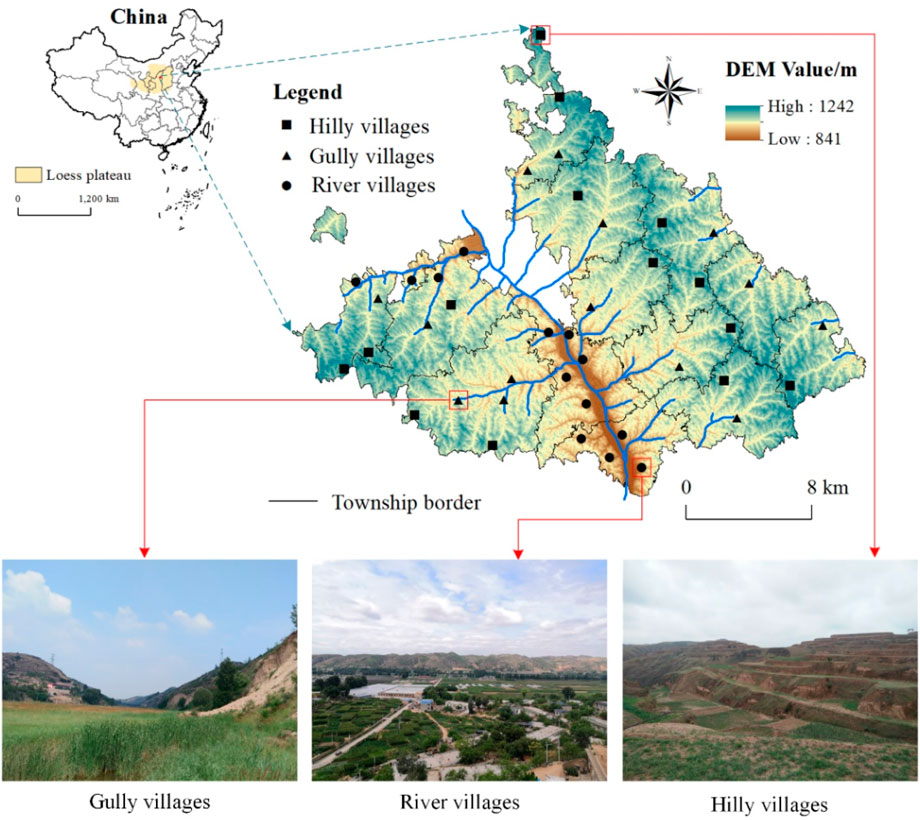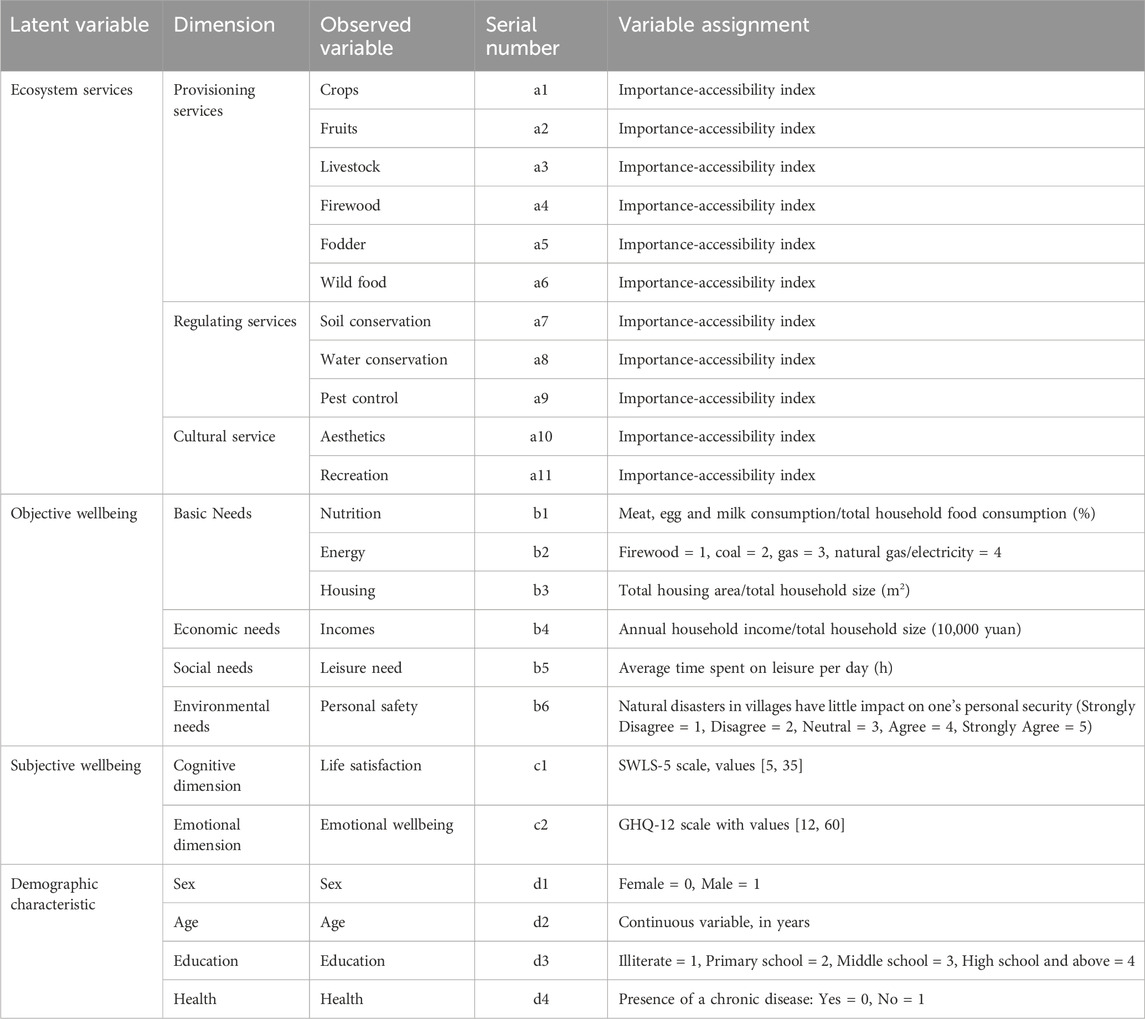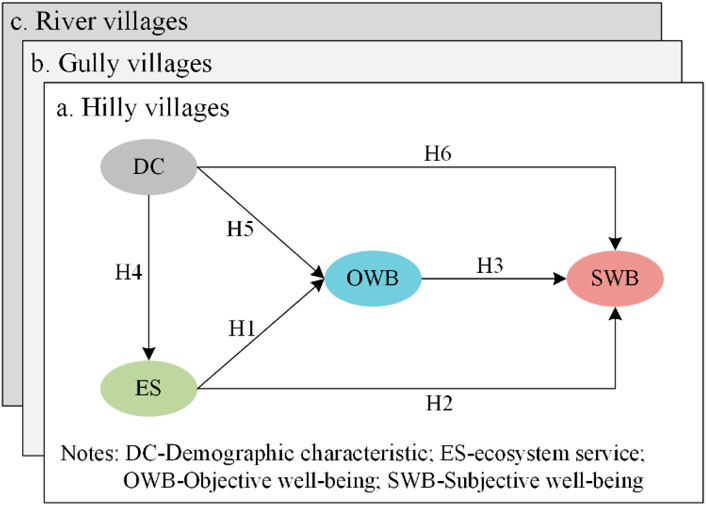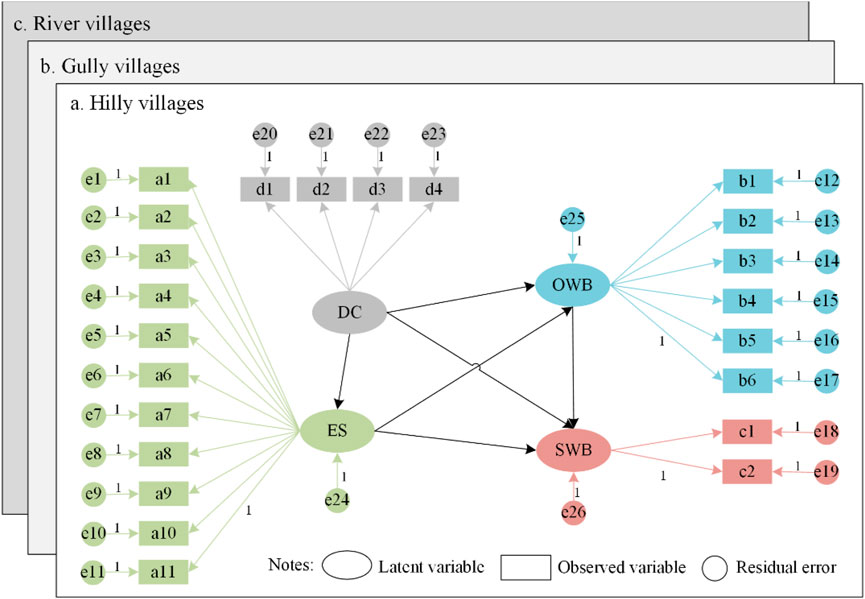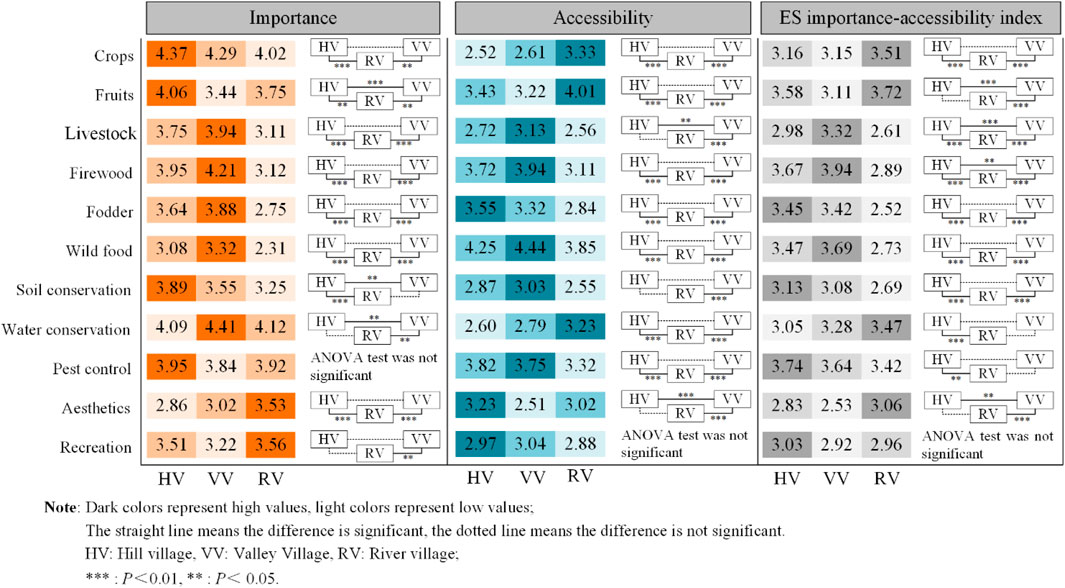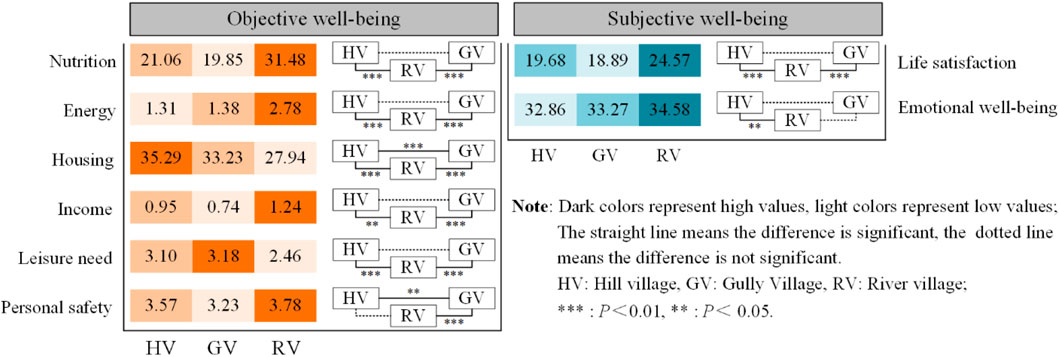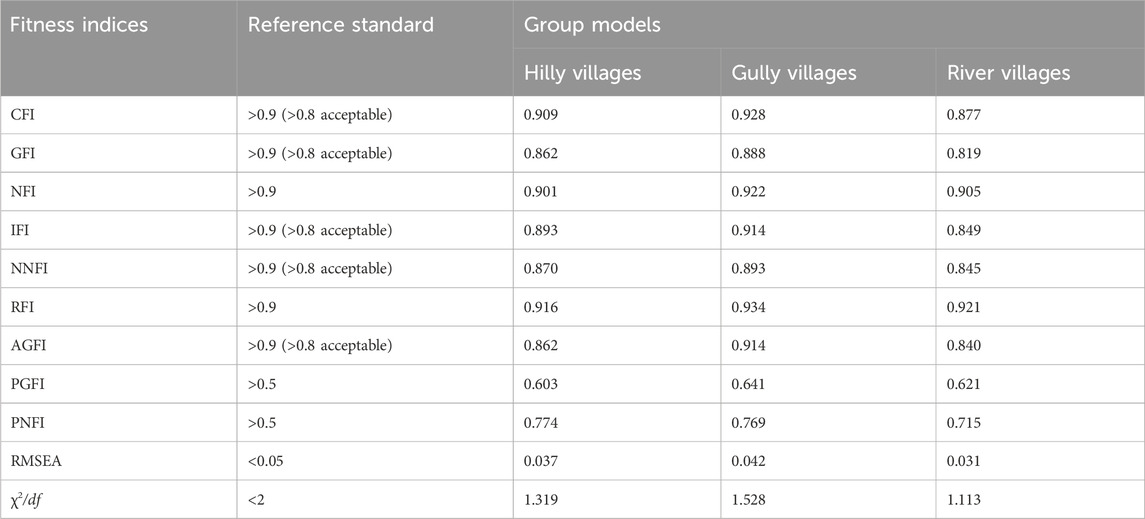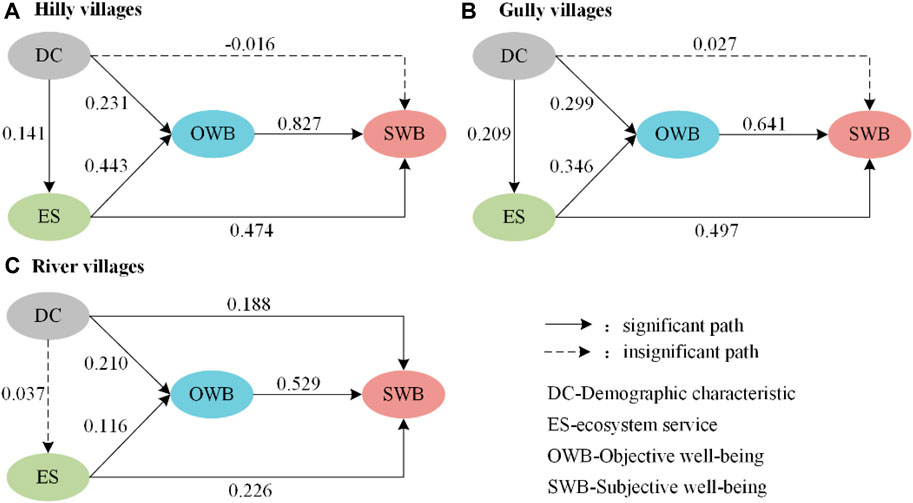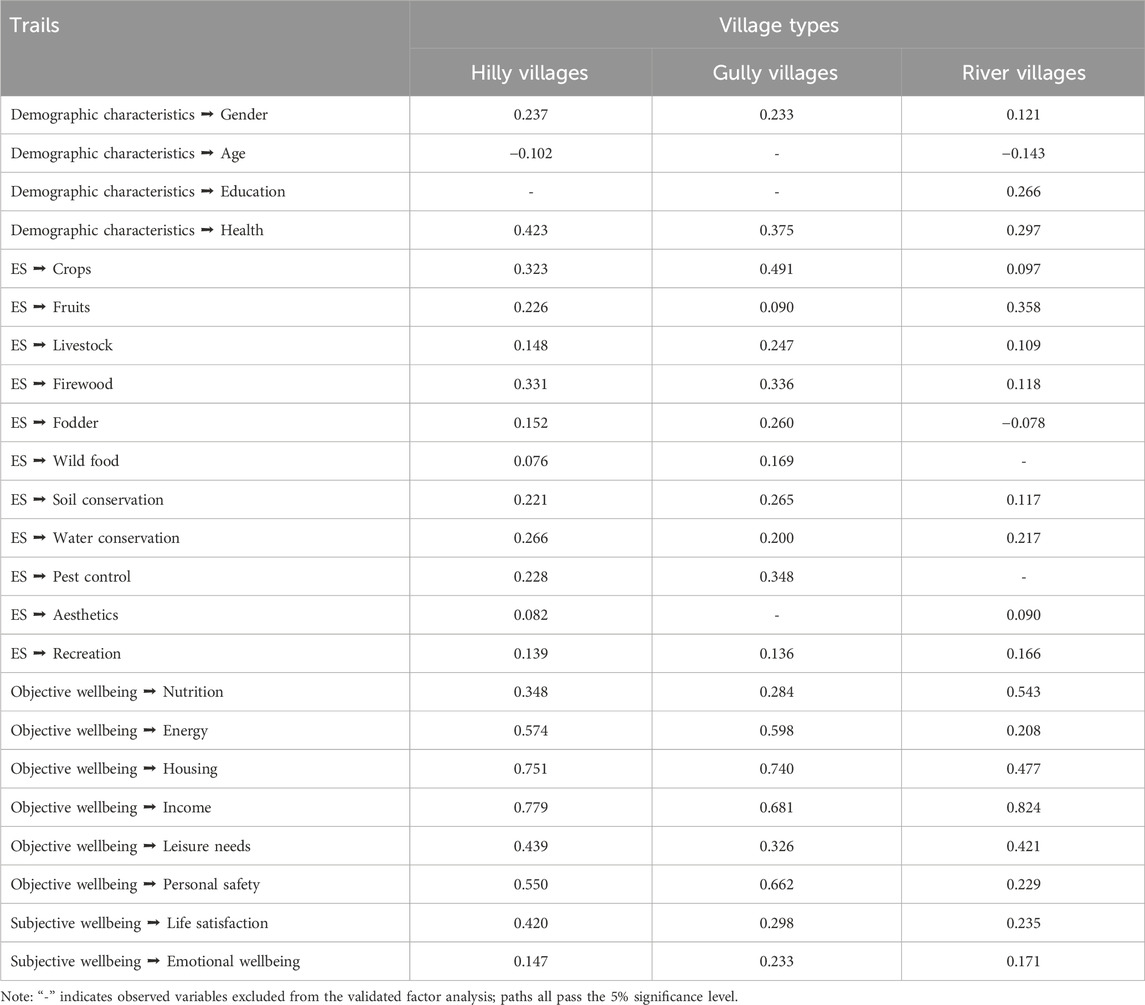Regional differences for the impacts of ecosystem services on farmers’ wellbeing: a case study of the Loess Plateau, China
- 1College of Urban and Environmental Science, Northwest University, Xi’an, China
- 2School of Tourism, Henan Normal University, Xinxiang, China
- 3School of Energy Engineering, Xi’an University of Science and Technology, Xi’an, China
Introduction: Different land use patterns affect access to ecosystem services as well as differences in farmers’ well-being.
Methods: The Loess Plateau, which has a fragile ecological environment, was chosen as the study region. On the one hand, information on the importance and accessibility of ESs, as well as the subjective and objective well-being of farmers, was obtained through semistructured interviews and questionnaires. On the other hand, regional differences for the impact of ESs on the well-being of farmers were explored based on a structural equation model.
Results: The results indicated that the impact of ESs on farmers’ well-being was crucial for all three village types, but the extent of the impact varied, and the key ESs varied across villages. For hilly villages and gully villages, crops and firewood were the two common ES types that were important. However, water conservation was the key ES type for farmers in hilly villages, and pest control was the key ES type for farmers in gully villages. Fruits, water conservation and recreation were the key ES types in the river villages.
Discussion: A focus on the regional differences for the impacts of ESs on farmers’ well-being is meaningful for policy practice. We can contribute to farmers’ well-being by optimising land use allocation and land ecological control to improve their ES access in different regions, which is effective in differentiating and enhancing the sustainability of different regions.
1 Introduction
Ecosystem services (ESs) refer to a variety of material and nonmaterial benefits that people derive from ecosystems (Costanza et al., 2017), which contribute beneficially to both the objective and subjective dimensions of human wellbeing (Cruz-Garcia et al., 2017). The Millennium Ecosystem Assessment (Millennium Ecosystem Assessment, 2005) has enabled several scholars to show the significant impact of ESs on human wellbeing through empirical studies (Hou et al., 2014; Hossain et al., 2017). However, most of these researchers have focused on the overall ESs and human wellbeing of a region, ignoring regional differences and thus reducing the efficiency of policy management to the detriment of regional sustainable ecosystem management (Daw et al., 2011). Currently, the exploration of regional differences in the impacts of ESs on human wellbeing is a pressing issue; it is the key to understanding the dynamics and differentiation of socioecological systems in a region and thus can contribute to the development of region-specific land management decisions (Castro et al., 2016).
Over the past decade, researchers have endeavoured to study the relationship between ESs and wellbeing at the microindividual scale to incorporate the needs of different beneficiaries into land management and policies (Oteros-Rozas et al., 2014; Ma et al., 2016). However, microscale ES and human wellbeing studies have mostly focused on assessing the importance of ESs (Lau et al., 2018; Ali et al., 2020), as well as objective dimensions (Robinson et al., 2019) or subjective dimensions of human wellbeing (Huang et al., 2020). Currently, very few studies have simultaneously addressed both multiattribute assessments of ESs and integrated assessments of subjective and objective dimensions of wellbeing. This is clearly detrimental to a complete understanding of the impact of ESs on human wellbeing. On the one hand, importance assessments of ESs at the microscale reflect the expectations and needs for ESs (Scholte et al., 2015; Zoderer et al., 2019); however, these assessments cannot sufficiently represent the ways in which specific ES types effectively influence and contribute to individual wellbeing (Abunge et al., 2013; Liu et al., 2022). For example, firewood was a highly demanded ES type for forest community farmers in Nepal. However, there were significant differences in the accessibility of firewood among farmers due to different divisions of power in the community, which led to different wellbeing outcomes (Chaudhary et al., 2018). Therefore, our goal is to correlate the importance and accessibility of ESs to more effectively assess the true demand and use of ESs at the individual level. There is a lack of research in this area. On the other hand, the study of human wellbeing at large scales makes it difficult to obtain a complete understanding of wellbeing, especially in assessing subjective wellbeing (Leviston et al., 2018; Wang et al., 2021). The microscale provides an effective yardstick for a deeper understanding of the multidimensionality and social differentiation of wellbeing (Costanza et al., 2014). However, even when operationalized at the microscale, researchers have focused mostly on the impact of ESs on objective wellbeing (Jones et al., 2019) or on subjective wellbeing (Iniesta-Arandia et al., 2014; Wei et al., 2018; Huang et al., 2020). Such one-dimensional impact studies prevent us from understanding the complete contribution of ESs to wellbeing; thus, comprehensive assessments of both objective and subjective wellbeing are necessary to facilitate this understanding (Smith et al., 2013; Agarwala et al., 2014). However, few studies have been conducted to effectively explore the effects of ESs on subjective and objective wellbeing.
Individual levels of ES use and wellbeing vary significantly across regions (Wang et al., 2017; Wei et al., 2018), which leads to regional differences in the impact of ESs on wellbeing (Hicks and Cinner, 2014; Oteros-Rozas et al., 2017). For example, rural populations in the Andean region place more importance on provisioning services (food and water), while urban residents have a greater preference for cultural services related to education and recreation (Aguado et al., 2018). Residents of remote rural areas in Scotland have significantly greater subjective wellbeing than do near-urban rural residents (Gilbert et al., 2016). Urban residents in arid catchments prefer basic physical materials, while rural residents are more satisfied with their safety and health (Yang et al., 2019). In addition, more studies have shown that the more dependent a community is on ecosystems, the greater the impact and contribution of its residents’ ES on wellbeing (Robinson et al., 2019; Kibria et al., 2022). Numerous studies have provided initial insights into regional differences in ESs and human wellbeing, but most of the research on regional differences for the impact of ESs on human wellbeing has been qualitative. Due to its ability to explain the relationships between latent variables, the structural equation model provides an opportunity for the studies in this paper (Santos-Martín et al., 2013; Qiu et al., 2022) to improve the quantitative understanding of the regional differences in the impact of ESs on wellbeing.
In this study, three types of villages within Mizhi County on the Loess Plateau of China were used to represent three types of regions, and regional differences for the impact of ESs on farmers’ wellbeing were analysed. First, we assessed the importance and accessibility of ESs and the subjective and objective wellbeing of farmers through questionnaires and face-to-face interviews. Second, we analysed regional differences in ES use levels and farmers’ wellbeing levels. Finally, a structural equation model was used to reveal regional differences in the impact of ESs on wellbeing. The results of this study help us to further understand ES use and its impact on farmers’ wellbeing in different regions to provide some effective ideas and measures for differentiated sustainable ecosystem management.
2 Materials and methods
2.1 Study area
Mizhi County in Shaanxi Province, China, is used as the study area in this paper. This area is in the centre of the Loess Plateau and is a typical loess hilly and gully region (Figure 1). Climatically, Mizhi County has a temperate semiarid climate with low annual precipitation, which averages 451 mm. The distribution of precipitation is very uneven within the year; there are many heavy rainfall events in summer, and droughts and floods occur occasionally. Local farmers use the phrase “nine droughts in 10 years” to describe the local climate, which severely limits agricultural development. The Loess Plateau is one of the most severely eroded areas in the world, especially in the loess hilly and gully region. In abnormal years, landslides and flash floods are frequent in the region, seriously affecting farmers’ agricultural practices while threatening their personal and property safety. Local farmers are mainly dependent on various types of benefits derived from agro-ecosystems. The cultivation of dry season crops such as cereals, maize, potatoes, and red beans and the breeding of livestock such as goats and pigs are the most important sources of livelihoods for farmers and greatly contribute to their wellbeing. In recent years, the growth of apple orchards has also provided ways for farmers to improve their livelihoods. Furthermore, ecological compensation is an effective policy for the Chinese government to address land degradation, which has produced a large forest area. Farmers obtain firewood and food from these forests, which also improves their wellbeing.
The research group spent nearly 10 years engaged in fieldwork in Mizhi County, during which time they found that the region contains typical and rich topographic units and landscapes of the Loess Plateau. According to the differences in topography and land use types, Mizhi County can be roughly divided into hilly regions, gully regions, and river regions (Figure 1), leading to large differences in natural and socioeconomic conditions among villages (Table 1). In this paper, the sample villages were selected through stratified sampling of different village types. According to the differences in economic development and demographic structure, we selected 14 villages in the hilly region, 14 villages in the gully region, and 13 villages in the river region. The different village types reflect different land use patterns, which can have a strong impact on ES preferences and access, as well as on the level of farmers’ wellbeing. Therefore, we focus on the differences in ESs and farmers’ wellbeing levels due to village differences and reveal the variability in the processes by which ESs affect farmers’ wellbeing.
2.2 Survey methodology
The research data for this paper came from social surveys conducted in October 2020 and July 2021 by the research group. Six and eight postgraduate students were involved in data collection during the two periods, respectively. The questionnaire survey was completed through random sampling of farmers in these villages. Because of the time required to complete the questionnaire, the researcher randomly selected farmers in each village who were willing to participate in the questionnaire survey. Although the questionnaire survey was conducted at the individual level, our sampling unit was the farm household, i.e., one household per survey form (Aguado et al., 2018).
The questionnaire consisted of three main parts. The first part assessed the importance and accessibility of ESs. ESs were assessed through Likert scales and picture information methods and contained some open questions. The second part assessed farmers’ wellbeing, including objective wellbeing assessment based on human needs theory and subjective wellbeing assessment based on the SWLS-5 scale and GHQ-12 scale. The third part collected information on demographic characteristics, including sex, age, education, and health status (Table 2). To facilitate the comparison of results between topographic regions, we used the same ES types and wellbeing dimensions for all farmers.
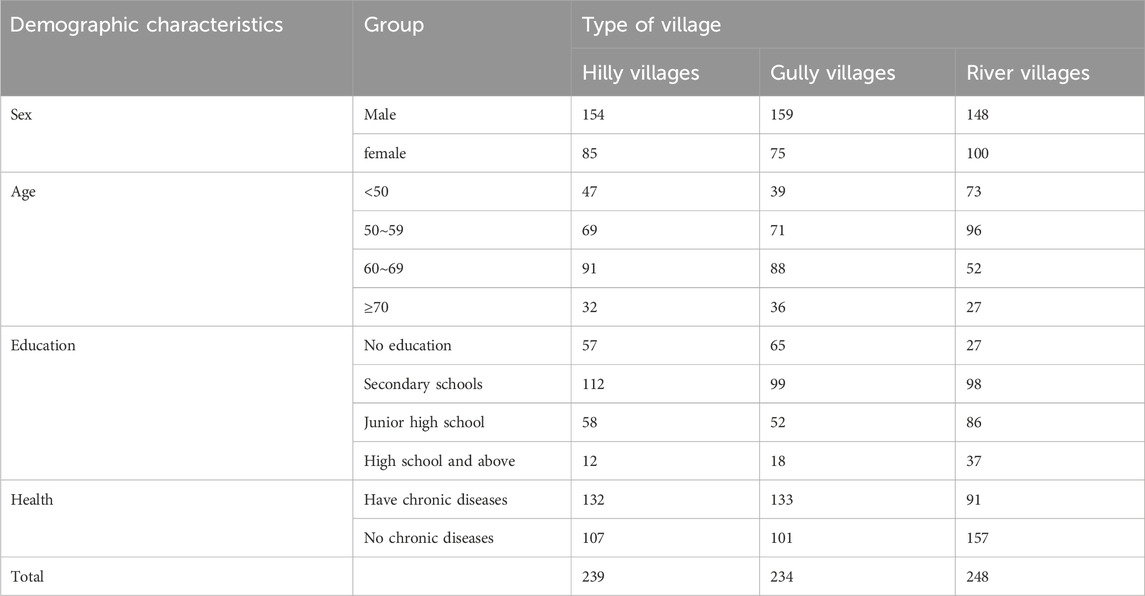
Table 2. Demographic characteristics of participating farm households in different types of villages.
2.2.1 ES assessment
Farmers on the Loess Plateau rely heavily on various types of ESs because they contribute significantly to their wellbeing (Liu et al., 2022). The determination of ES types in this paper followed the generalized ES classification criteria of MA (MA et al., 2016). At the same time, we fully considered the actual situation of local agroecosystems while selecting the ES types obtained in the initial survey in July 2019 during interviews with farmers. Finally, six provisioning services, three regulating services and two cultural services were identified. Due to the similarity between supporting services and regulating services, as well as the fact that most of the ES types were difficult for the respondents to understand, we did not assess support services, considering the efficiency of the assessment (Ciftcioglu, 2017b). Provisioning services include crops, fruits, livestock, firewood, fodder, and wild food; regulating services include soil conservation, water conservation, and pest control; and cultural services include aesthetics and recreation (Table 3).
This paper assessed the importance and accessibility of ESs. The importance of an ES reflects a farmer’s preference for a particular ES, while the accessibility of an ES reflects how easy it is for a farmer to access that ES (Abunge et al., 2013). Most previous studies have focused on the importance of certain ESs (Martín-López et al., 2014; Scholte et al., 2015), with little attention given to whether these ESs are accessible, leading to high estimates of ES contributions to wellbeing. For example, the fact that most farmers recognize the importance of crops does not mean that their contribution to wellbeing is obvious. Because access to crops is influenced by climate, the contribution of crops to farmers’ wellbeing is very limited in anomalous years (Liu et al., 2022). To express the contribution of ESs to wellbeing more scientifically, we constructed an ES importance-accessibility index to express the level of ES use by farmers (Eq. 1). The formula is as follows:
where
The rating method for ESs is considered a valid method for assessing ES preferences and perceptions on an individual scale (Shi et al., 2020a). The assessment method consists of three steps. First, animated picture cards containing information about Ess were shown and explained to the interviewed farmers by the researcher before they were rated. The local area is relatively poor, and the education level of the farmers is generally low; these factors contribute to the lack of a deep understanding of ESs. The visual information expressed through the pictures ensured that the farmers could well understand the meaning of ESs and the differences between types (Jones et al., 2019). Second, the researchers guided the farmers to place the picture cards according to the Likert scale. On the ES importance scale, one represents the least important type of ES, and five represents the most important type of ES; on the ES accessibility scale, one represents the hardest type of ES to access, and five represents the easiest type of ES to access. The researchers then collected the scores and coded the results. Finally, they conducted semistructured interviews with the respondents based on the results. The farmers were asked why some ESs were very important and why certain ESs were difficult to access. The whole scoring process and interview lasted approximately 20 min.
2.2.2 Assessment of farmers’ wellbeing
Human wellbeing is a comprehensive and multidimensional concept that is an objective expression of an individual’s current life situation; it also indicates the individual’s subjective perceptions and feelings (King et al., 2014). The characterization of human wellbeing through objective and subjective wellbeing has been validated by many scholars (Agarwala et al., 2014).
Objective wellbeing is a comprehensive concept characterizing the dimensions of people’s objective living conditions, economic level, and social relations (Smith et al., 2013) and has been developed in studies such as the Human Development Index (HDI) (Liu et al., 2018), capacity theory (Sangha et al., 2015), human needs theory (Robinson et al., 2019) and other effective assessment frameworks. Among them, human needs theory provides a viable approach for quantifying objective wellbeing due to its multidimensional needs assessment perspective (Summers et al., 2012; Chaigneau et al., 2019). Based on the actual situation of farmers in the study area, this paper constructed a system of objective wellbeing indicators for farmers (Table 3). Basic needs comprise a list of “necessities” that provide individuals with essential elements for survival and development (O'Neill et al., 2018). In this paper, basic needs were characterized through three elements: nutrition, energy, and housing. Economic needs are described as the degree to which individuals are satisfied with the level of economic resources they have and are characterized by income adequacy (Folbre, 2009). Currently, annual per capita income remains the main indicator characterizing farmers’ wellbeing in economically deprived areas (Mahajan and Daw, 2016). Social needs reflect the extent to which people demand noneconomic factors (Smith et al., 2013); in this study, the focus was on assessing the leisure needs of farmers. Leisure needs represent the ability of farmers to satisfy their own social interactions via connections with others in leisure activities (Dou et al., 2020) and are a key component of social needs. Environmental needs are the degree to which farmers are satisfied with the ability of their surroundings to support their survival and development (Yang et al., 2018); in this study, the focus was on assessing personal safety.
Subjective wellbeing refers to farmers’ satisfaction with their life status as well as their own emotional state, which has both cognitive and affective dimensions (King et al., 2014; Costanza et al., 2017). In studies of ESs and human wellbeing, most characterizations of subjective wellbeing involve only the cognitive dimension, i.e., life satisfaction. In this study, the common Life Satisfaction Scale and Emotional Wellbeing Scale were used to characterize the cognitive and affective dimensions, respectively.
2.3 Data analysis
2.3.1 Means comparison
One-sample analysis of variance (ANOVA) was used to test the significance of differences in ES importance, accessibility, objective wellbeing, and subjective wellbeing among farmers in different villages. Multiple comparisons were performed on the groups that passed the significance test. We used the Scheffe method of multiple comparison analysis for two-by-two comparisons of ES importance, accessibility, objective wellbeing, and subjective wellbeing of farmers in different villages to determine the significance of differences between groups (Radford and James, 2013). Both one-sample variance and the Scheffe method were tested in SPSS 22.0 statistical software.
2.3.2 Structural equation model
The effect of ESs on human wellbeing in this paper refers to the process by which the type and amount of ESs in a local agroecosystem contribute to farmers’ wellbeing (Wang et al., 2021). To this end, in this paper, an analytical framework for determining the contribution of the ESs to human wellbeing was designed (Figure 2). Because the effects of ESs on objective and subjective wellbeing are different, farmers’ wellbeing is decomposed into objective and subjective wellbeing (Iniesta-Arandia et al., 2014; Hossain et al., 2017). Figure 2 shows that the latent variables have a unidirectional influence on each other. First, farmers’ demographic characteristics are key factors influencing their development of livelihood strategies and, consequently, their access to ESs and human wellbeing (Daw et al., 2016; Berbés-Blázquez et al., 2017). For example, studies have shown that with increasing education level, more attention will be given to the value of therapeutics (Shi et al., 2020), residents in good health will also have greater objective wellbeing (Yang et al., 2018), and young people will have greater subjective wellbeing than older people (Fang et al., 2024). Second, the type and amount of ESs accessed by farmers influence both the objective and subjective dimensions of farmers’ wellbeing (Jones et al., 2019). For example, farmers have gained many economic benefits in the ecosystem, which is beneficial to many dimensions of objective wellbeing (Robinson et al., 2019). Moreover, studies have shown that the water conservation level will affect the subjective wellbeing of local elderly groups (Huang et al., 2020). Third, objective wellbeing has a direct and significant impact on subjective wellbeing (Schwanen and Wang, 2014). For example, income has a direct positive effect on quality of life and happiness (Mark et al., 2016).
Therefore, based on the literature supporting the research questions, six research hypotheses on the impact of ESs on human wellbeing are proposed in this paper. The hypotheses are as follows: H1: farmers’ ESs have a direct positive effect on farmers’ objective wellbeing; H2: farmers’ ESs have a direct positive effect on farmers’ subjective wellbeing; H3: farmers’ objective wellbeing has a direct positive effect on farmers’ subjective wellbeing; H4: farmers’ demographic characteristics have a direct positive effect on farmers’ ESs; H5: farmers’ demographic characteristics have a direct positive effect on farmers’ objective wellbeing; H6: farmers’ demographic characteristics have a direct positive effect on farmers’ subjective wellbeing.
The impact of farmers’ ESs on their wellbeing is a unidirectional relationship between multivariate groups, and traditional correlation analysis and typical correlation analysis cannot solve the unidirectional relationship between multiple groups of variables, which is the greatest advantage of the structural equation model (SEM) (Santos-Martín et al., 2013; Qiu et al., 2022). SEM is a multivariate statistical method used to analyse the complex relationships among variables based on covariance matrices; this method integrates various methods, such as linear regression analysis, factor analysis, and path analysis, and can be used to reveal multicausal linkages and intervariable relationships. SEM includes 1) a measurement model, which reflects the quantitative relationship between the observed variables and the corresponding latent variables, and 2) a structural model, which reflects the structural relationship between latent variables. The matrix equation for the measurement model is as follows (Eq. 2):
where Χ and Y are exogenous and endogenous explicit variables, respectively; Λx is the factor loading of the variable Χ on ω; Λy is the factor loading of the Y variable on η; δ and ε are the errors of the Χ and Y variables, respectively; η is the endogenous latent variable; and ω is the exogenous latent variable. The matrix equation for the structural model is as follows (Eq. 3):
where η is the endogenous latent variable, ω is the exogenous latent variable, α is the matrix of structural coefficients of the endogenous latent variable, β is the matrix of structural coefficients between the exogenous latent variable and the endogenous latent variable, and γ is the residual of the structural equation.
An initial model was established based on the research hypotheses. The farmers’ demographic characteristics were taken as exogenous latent variables; ESs, farmers’ objective wellbeing, and subjective wellbeing were taken as endogenous latent variables; and observational variables were set for the latent variables, constituting a structural equation model containing four latent variables and 23 observational variables (Figure 3). The calculations of the observational variables are shown in Table 2.
3 Results
3.1 Regional differences in ES and farmers’ wellbeing
3.1.1 Regional differences in ESs
The importance, accessibility and regional differences of farmers’ ESs in the ESIA are shown in Figure 4. The results of the one-sample ANOVA test showed that the importance and accessibility of all ES types were significantly different among villages, except for the importance of pest control (p = 0.659) and accessibility of recreation (p = 0.530). The results of the ES importance showed that three types of ESs, crop, fruit, and soil conservation, were the most important in the hilly villages. Pest control, although also highest in hilly villages, did not differ significantly from that in the other two villages. The importance of five types of ESs—livestock, fuel wood, fodder, wild food, and water conservation—was highest in gully villages. The cultural service categories of aesthetics and recreation were both highest for river villages, but many of the ES types in river villages had the lowest importance in comparison with other villages. In terms of ES accessibility, only the accessibility of fodder, aesthetics and recreation was highest in the gully villages, but the accessibility of recreation did not differ significantly among the villages. Moreover, the accessibility of five types of ESs, namely, livestock, fuel wood, wild food, soil conservation and pest control, was greater in gully villages than in the other two categories. Finally, crops, fruits, and water conservation had the highest accessibility in the riverine villages. The importance and accessibility of ESs were integrated into an index to obtain the ESIA. The ESIA for fodder, soil conservation, pest control and recreation scored the highest in the village comparison for hilly villages, but the difference in villages for recreation was not significant. The ESIA for the three ES types of livestock, fuel wood and wild food were the highest in gully villages. The ESIA indices for the four ES types of crops, fruits, water conservation, and aesthetics were the highest among the river villages.
3.1.2 Regional differences in farmers’ wellbeing
Regional differences in farmers’ wellbeing are illustrated in Figure 5. The results of the one-sample ANOVA test showed that all wellbeing indicators have significant village differences. Among the objective wellbeing indicators, the level of fulfilment of nutritional, energy, income and security needs of farm households in river villages was greater than that in hilly villages and gully villages. In the comparison of mean differences, the differences between the indicators of nutrition, energy, and income needs of farmers in river villages and those in hilly villages and gully villages were significant. The difference between the personal safety indicators of farmers in river villages and hilly villages was not significant, while the difference with gully villages was shown to be significant. The level of fulfilment of housing needs was greater in hilly villages than in gully villages and significantly lower in river villages. The results of the comparison of the means of the housing indicators revealed differences among the three indicators in terms of housing need fulfilment. The leisure needs of farmers in gully villages were greater than those in hilly villages and significantly greater than those in river villages. Farmers’ households in hilly villages and gully villages maintained similar leisure needs, and there were significant differences between them and farmers’ households in river villages. Subjective wellbeing consists of two indicators. The mean values of life satisfaction and emotional wellbeing of farmers in river villages were greater than those in hilly villages and gully villages. For life satisfaction, this difference is significant for both; for emotional health, the emotional health of farmers in river villages significantly differed from that of farmers in hilly villages, but the difference between their emotional health and that of farmers in gully villages was not significant.
3.2 Regional differences in the impact of ESs on farmers’ wellbeing
3.2.1 Model fit indices
The impact models for the different village types were run separately in AMOS 23.0 software. First, a first-order validation factor analysis was applied to each of the three models using maximum likelihood estimation to remove significant variables with insignificant factor loadings (C.R. < 1.96). The education variable (d3) was removed from the farmer model in hilly villages. Aesthetics (a10), age (d2), and education (d3) were removed from the farmer model in gully villages. Wild food (a6) and pest control (a9) were removed from the farmer model in the river villages. Subsequently, a secondary validation factor analysis was conducted for each model, followed by a fitness test based on the correction indices; the results are shown in Table 4. After connecting the model residuals one by one, most of the fit indices improved and met the fitness criteria. Subsequently, the initial conceptual models with nonsignificant significant variables of effect removed were run separately, and the fit of the models was corrected. Most of the fit indices of the corrected structural models met the fit criteria, and the model fit results were satisfactory.
3.2.2 Regional differences for the impacts of ESs on human wellbeing
The results of regional differences in the pathways of ES impact on human wellbeing are shown in Figure 6. The direct impact of demographic characteristics on farmers’ subjective wellbeing in hilly villages and gully villages is non-significant, so hypothesis H6 does not hold in these two models, and hypotheses H1-H5 hold. The direct effect of the demographic characteristics of farmers in river villages on ESs was not significant, so hypothesis H4 was not valid in the model of farmers in river villages, although hypotheses H1-H3 and H5-H6 were valid. The direct effect of ESs on subjective and objective wellbeing was significantly greater in hilly villages and gully villages than in river villages, and the direct effect of ESs on objective wellbeing was smaller than the direct effect on subjective wellbeing in all three models. The effect of objective wellbeing on subjective wellbeing was greatest in hilly villages, followed by gully villages and river villages. Regarding the effect of demographic characteristics, the effect of demographic characteristics on ESs was significantly greater for farmers in gully villages than for farmers in hilly villages. The direct effects of demographic characteristics on farmers’ objective wellbeing were all significant, and the direct effects were greater in gully villages than in hilly villages and greater in river villages. The direct effect of demographic characteristics on subjective wellbeing was significant only for farmers in river villages.
Table 5 shows the regional differences in impact effects among the latent variables. There were some significant indirect effects in the influence process of the latent variables. First, the indirect effects of ESs on subjective wellbeing were all significant; that is, farmers increased the level of need for objective wellbeing by increasing ES, which in turn contributed to their subjective wellbeing, and the effect of this process was significantly greater in hilly villages and gully villages than in river villages. Second, demographic characteristics had some indirect effects on objective wellbeing, but the effects were weak and nonsignificant in the model for farmers in river villages. For hilly villages and gully villages, farmers’ demographic characteristics can improve their subjective wellbeing by increasing their objective wellbeing. Finally, the indirect effects of demographic characteristics on subjective wellbeing were significant and significantly greater in hilly villages and gully villages than in river villages. In both hilly villages and gully villages, the effects of demographic characteristics on the subjective wellbeing of farmers tended not to be direct but rather had an effect through ES acquisition and objective wellbeing fulfilment. In terms of total effects, the total effects were overall greater in hilly villages and gully villages than in river villages.
Table 6 shows the factor contributions of the observed variables in the different village models. We defined indicators with higher factor contributions as key ESs. The types of key ES are significantly different across village types. Multiple types of provisioning services contribute differently to farmers’ wellbeing in different village types, except for the wild food service factor contribution in river villages, which is not significant. For example, farmers in hilly villages and gully villages significantly improved their wellbeing through crops, whereas the crop indicator in the model for farmers in river villages made a very limited contribution to their wellbeing. However, the factor contribution of fruits was highest in river villages and lowest in gully villages. Farmers also recognized the positive contribution of regulating services to human wellbeing. For example, for both hilly villages and river village farmers, water conservation was the key regulating service type that influenced their access to wellbeing, while pest control was the key regulating service type that influenced the wellbeing of gully village farmers. Cultural services also contributed to farmers’ wellbeing, and the contribution of recreation to wellbeing was significantly greater than that of aesthetics. Among the two types of cultural services, the factor values did not differ significantly between villages, except for the factor contribution of aesthetics in gully villages, which was not significant.
There were significant differences in the types of human wellbeing that were key to the different village models. For example, the contribution of nutritional needs to wellbeing was significantly greater for farmers in river villages than for those in the other two types of villages. At the same time, the factor contributions of energy needs, housing needs, and security needs were significantly lower in river villages than in the other two types of villages. The values of factor contributions to income needs and leisure needs were more consistent across the three villages. In terms of key objective wellbeing in the single model, the farmers’ key objective wellbeing in hilly villages was income, housing and energy; the farmers’ key objective wellbeing in gully villages was housing, income and personal safety; and the farmers’ key objective wellbeing in river villages was income, nutrition and housing. In terms of subjective wellbeing, the factor contribution of life satisfaction was significantly greater than that of emotional wellbeing and was more pronounced in the model of hilly village farmers.
4 Discussion
4.1 Regional differences in ES and wellbeing
The spatial distribution of land use and land cover and its changes in ecologically fragile areas are the result of the natural geographic pattern of the region and the long-term transformation by farmers (Wang et al., 2021). On the one hand, natural geography creates regional differences in land use types, which is the primary consideration when selecting villages. On the other hand, the evolution of land use represents differences in the way farmers utilize local natural resources while reflecting different livelihood strategies. In this study, regional differences in land use patterns were represented by categorizing villages. Different village types represent regional differences in land use. In this section, we focus on the differences in the level of ES use and the level of farmers’ wellbeing caused by regional differences in land use patterns.
The results of the ES village comparisons revealed that hilly villages and gully villages had significantly greater preferences for most provisioning services than river villages did, which is similar to many ES studies on rural‒urban differences (Aguado et al., 2018; Seda Arslan et al., 2021), for example, crops, firewood, and fodder. The importance of fruits differed significantly in all three types of villages, mainly due to farmers’ biased understanding of the importance of fruits (Liu et al., 2022). Hilly villages favour growing mountain apples due to more terraced fields, which provides them with economic gains that make them favour fruit services. River villages, which are closer to the county, strongly recognize the nutritional value of fruits and the nutritional benefits they bring to them, making them more partial to fruit services. Accessibility is an interesting concept, and we found that certain very important types of ESs are not easy to access. For example, the high importance and low accessibility of crops are especially evident in hilly villages. Hilly villages are furthest from county towns and have the highest dependence of farmers on agriculture, making crops the most important for livelihoods. At the same time, hilly villages are mostly terraced and do not have access to irrigation, so the abundance of crops is directly related to the local climate, which makes them difficult to access. Of course, there are times when the importance and accessibility of ESs are synergistic. For example, firewood has the highest importance and the highest accessibility in gully villages. Much of the land in gully villages is covered by forestland and is affected by the policy of returning farmland to forest. Farmers in gully villages often collect firewood from forestland, which is an important non-remunerated benefit that can replace the use of coal and electricity, so firewood is important and accessible to them.
The ESIA relates the importance and accessibility of ESs together, thus expressing the level of ES use by farmers. For example, crops in Hilly Villages are the most important ES but are difficult to access compared with the other two villages, so its ESIA is medium; the same is true of recreation services. In other words, the ESIA corrects the overestimation problem of the past when only importance is assessed, so this method appears to be more accurate in the assessment process of the ES level received by farmers (Liu et al., 2022). The ESIA includes not only the demand of farmers for a certain ES but also the degree of farmers’ access to this ES (Abunge et al., 2013). Therefore, the ESIA can be used as a comprehensive indicator of farmers’ demand for and access to ESs to understand farmers’ use level of ESs.
Regional differences in farmers’ wellbeing are also evident. Most of the dimensions of farmers’ needs in river villages were greater than those in the other two types of villages, which can still be interpreted as a difference between urban and rural areas (Gilbert et al., 2016), e.g., income levels and personal safety dimensions. The former implies that the income level of farmers in river villages was significantly greater than that of farmers in the other two types of villages that are farther away from urban areas; the latter reflects the fact that the overall topography of river villages maintains the personal safety of local farmers. Objective wellbeing has a significant effect on subjective wellbeing, which has been confirmed in many studies (Agarwala et al., 2014). The farmers’ subjective wellbeing in the river villages where most of the needs were met in this study was also greater than that in the other two types of villages, although we did not perform a regression analysis.
4.2 Regional differences in ES impacts on wellbeing
The impact of ESs on human wellbeing is uncertain, and this impact varies by group and can also vary by region (Wei et al., 2018). For example, for population groups that do not rely on agricultural production, the impact of local ESs on their wellbeing is very limited. In urban areas, ESs do not contribute as much to human wellbeing as they do in rural areas (Aguado et al., 2018). In this section, we focus on differences in the impact of ESs on farmers’ wellbeing caused by differences in land use patterns.
The contributions of ESs to farmers’ wellbeing are significantly regionally different. Among the latent variables, ESs contribute the most to objective wellbeing for farmers in hilly villages, followed by gully villages and finally river villages. Farmers in hilly villages and gully villages are more dependent on income obtained from agricultural farming and have access to resources from forestland. This reflects the differences in the dependence of farmers on different land uses. Among the explicit variable indicators, we identified key ES types and wellbeing types and found that these key indicators also varied among villages. For example, water conservation is a key regulating service that affects farmers’ wellbeing in both hilly villages and river villages in terms of their access to wellbeing. The water storage capacity of terraced fields in hilly areas is poor, drought is most severe in hilly villages, and water storage is important for farmers’ livelihoods in hilly villages (Ramos et al., 2018). The problem faced by river villages, on the other hand, is the impact of transient flooding, and improvements in the capacity of water storage are of obvious significance for agricultural practices and personal safety for farmers.
4.3 Implications of the findings for the sustainable management of regional ecosystems
This study provides useful insights into the sustainable management of ecosystems in ecologically fragile areas. Land use practices affect ES acquisition, which in turn contributes to farmers’ wellbeing. ES acquisition and farmers’ wellbeing in ecologically fragile areas can be improved through the scientific management of land use. According to our findings, there is a need for terracing in hilly villages and gully villages. For example, converting existing narrow terraces to wide terraces will facilitate crop growth and reduce water loss, which is meaningful for improving crop and water conservation access for farmers. In river villages, rivers need to be dredged to prevent flooding during heavy rains, which is also beneficial for water conservation. Moreover, the planning of more recreational sites in river villages is important for improving recreational accessibility. In conclusion, the research proposal and findings of this paper provide a way in which regional differences in ESs and farmers’ wellbeing can be recognized, which is essential for improving ES access and farmers’ wellbeing levels through appropriate ecological management.
4.4 Limitations of the study
First, the construction of the ESIA represents a novel attempt in this paper, but we lack relevant research for reference. We initially equated importance and accessibility as equally important in the ESIA. However, the weight of the two may vary for individuals. Therefore, it is necessary to further consider the weight of importance and accessibility by combining the characteristics of research regions and farmers in future studies to improve the applicability of the ESIA. Second, we employed a structural equation model to address the impact of ESs on human wellbeing, which has been proven effective in related studies. However, we have observed only the influence path of ESs on human wellbeing and have not observed the complex influence of ESs on specific dimensions of wellbeing. This constitutes a clear limitation of the structural equation model. Therefore, we need to adopt more appropriate and in-depth methods to explore the complexity of the pathway through which ESs impact wellbeing in future studies. Finally, the main issue addressed in this paper is the regional differences for the impact of ESs on farmers’ wellbeing. We use simple village categorization to represent differences across land use patterns, which may not be precise enough. That is, we did not explore ES access and farmers’ wellbeing levels with different land use types and orientations, which would have provided a stronger focus. Therefore, in the next step of the study, we will integrate and analyse the land use patterns, orientation, geomorphic features, and farmland structure of farmers, and we will divide farmer groups by differences in land use patterns to explore the differences in the multidimensional impacts of ESs on their wellbeing under different farmer groups. Such an analysis has local and practical implications for understanding the impact of land use on ESs and farmers’ wellbeing at the microscale.
5 Conclusion
The Loess Plateau is an economically underdeveloped region. How to improve the wellbeing of local farmers is an important issue. The solution to this problem requires management of the ecology of different regions, as this will increase the extent of ES use by farmers. The focus of this study was to investigate regional differences for the impact of ESs on farmers’ wellbeing. The results showed that the impact of ESs on farmers’ wellbeing in all three village types was significant, but the extent of the impact varied. The effect of ESs on farmers’ wellbeing was significantly greater in hilly villages and gully villages than in river villages; these effects are more closely related to those in county towns and are consistent with existing ideas from research on urban‒rural differences. The key types of ESs also varied across villages. For example, for hilly villages and gully villages, crops and firewood were the two key common ES types. However, water conservation was the key ES for farmers in hilly villages, and pest control was the key ES for farmers in gully villages. For farmers in river villages, the key ES types were quite different from those in the other two types of villages. Fruits, water conservation and recreation were the key ES types. A focus on the regional differences in ESs on farmers’ wellbeing is meaningful for policy practice. We can improve ES access for farmers by optimizing land use allocation and land ecological control, which is effective in differentiating and enhancing the sustainability of different regions.
Data availability statement
The original contributions presented in the study are included in the article/supplementary material, further inquiries can be directed to the corresponding author.
Ethics statement
Ethical review and approval was not required for the study on human participants in accordance with the local legislation and institutional requirements. Written informed consent from the patients/participants or their legal guardian/next of kin was not required to participate in this study in accordance with the national legislation and the institutional requirements.
Author contributions
WC: Conceptualization, Methodology, Validation, Writing–original draft. DL: Conceptualization, Methodology, Supervision, Visualization, Writing–review and editing. JZ: Funding acquisition, Project administration, Validation, Writing–review and editing.
Funding
The authors declare that financial support was received for the research, authorship, and/or publication of this article. This work was sponsored in part by the Key Technology Development Project of Xi’an University of Science and Technology (6000180160) and the Doctoral Research Project of Henan Normal University (20230077).
Conflict of interest
The authors declare that the research was conducted in the absence of any commercial or financial relationships that could be construed as a potential conflict of interest.
Publisher’s note
All claims expressed in this article are solely those of the authors and do not necessarily represent those of their affiliated organizations, or those of the publisher, the editors and the reviewers. Any product that may be evaluated in this article, or claim that may be made by its manufacturer, is not guaranteed or endorsed by the publisher.
References
Abunge, C., Coulthard, S., and Daw, T. M. (2013). Connecting marine ecosystem services to human well(-)being: insights from participatory well(-)being assessment in Kenya. Ambio 42, 1010–1021. doi:10.1007/s13280-013-0456-9
Agarwala, M., Atkinson, G., Fry, B. P., Homewood, K., Mourato, S., Rowcliffe, J. M., et al. (2014). Assessing the relationship between human well-being and ecosystem services: a review of frameworks. Conserv. Soc. 12, 437–449. doi:10.4103/0972-4923.155592
Aguado, M., González, J. A., López-Santiago, C., and Montes, C. (2018). Exploring subjective well-being and ecosystem services perception along a rural‒urban gradient in the high Andes of Ecuador. Ecosyst. Serv. 34, 1–10. doi:10.1016/j.ecoser.2018.09.002
Ali, M. A. S., Khan, S. U., Khan, A., Khan, A. A., and Zhao, M. J. (2020). Ranking of ecosystem services on the basis of willingness to pay: monetary assessment of a subset of ecosystem services in the Heihe River basin. Sci. Total Environ. 734, 139447. doi:10.1016/j.scitotenv.2020.139447
Berbés-Blázquez, M., Bunch, M. J., Mulvihill, P. R., Peterson, G. D., and van Wendel de Joode, B. (2017). Understanding how access shapes the transformation of ecosystem services to human well-being with an example from Costa Rica. Ecosyst. Serv. 28, 320–327. doi:10.1016/j.ecoser.2017.09.010
Castro, A. J., Vaughn, C. C., Julian, J. P., and García-Llorente, M. (2016). Social demand for ecosystem services and implications for watershed management. J. Am. Water. Resour. 52, 209–221. doi:10.1111/1752-1688.12379
Chaigneau, T., Brown, K., Coulthard, S., Daw, T. W., and Szaboova, L. (2019). Money, use and experience: identifying the mechanisms through which ecosystem services contribute to wellbeing in coastal Kenya and Mozambique. Ecosyst. Serv. 38, 100957. doi:10.1016/j.ecoser.2019.100957
Chaudhary, S., Mcgregor, A., Houston, D., and Chettri, N. (2018). Environmental justice and ecosystem services: a disaggregated analysis of community access to forest benefits in Nepal. Ecosyst. Serv. 29, 99–115. doi:10.1016/j.ecoser.2017.10.020
Ciftcioglu, C. G. (2017a). Assessment of the relationship between ecosystem services and human wellbeing in the social-ecological landscapes of Lefke Region in North Cyprus. Landsc. Ecol. 32, 897–913. doi:10.1007/s10980-017-0494-y
Ciftcioglu, C. G. (2017b). Social preference-based valuation of the links between home gardens, ecosystem services, and human well-being in Lefke Region of North Cyprus. Ecosyst. Serv. 25, 227–236. doi:10.1016/j.ecoser.2017.05.002
Costanza, R., de Groot, R., Braat, L., Kubiszewski, I., Fioramonti, L., Sutton, P., et al. (2017). Twenty years of ecosystem services: how far have we come and how far do we still need to go? Ecosyst. Serv. 28, 1–16. doi:10.1016/j.ecoser.2017.09.008
Costanza, R., Kubiszewski, I., Giovannini, E., Lovins, H., Mcglade, J., Pickett, K. E., et al. (2014). Development: time to leave gdp behind. Nature 505, 283–285. doi:10.1038/505283a
Cruz-Garcia, G. S., Sachet, E., Blundo-Canto, G., Vanegas, M., and Quintero, M. (2017). To what extent have the links between ecosystem services and human well-being been researched in Africa, Asia, and Latin America? Ecosyst. Serv. 25, 201–212. doi:10.1016/j.ecoser.2017.04.005
Daw, T., Brown, K., Rosendo, S., and Pomeroy, R. (2011). Applying the ecosystem services concept to poverty alleviation: the need to disaggregate human well-being. Environ. Conserv. 38, 370–379. doi:10.1017/s0376892911000506
Daw, T., Hicks, C., Brown, K., Chaigneau, T., Januchowski-Hartley, F., Cheung, W., et al. (2016). Elasticity in ecosystem services: exploring the variable relationship between ecosystems and human well-being. Ecol. Soc. 21, art11. doi:10.5751/es-08173-210211
Dou, Y. H., Yu, X. B., Bakker, M., de Groot, R., Carsjens, G. J., Duan, H. L., et al. (2020). Analysis of the relationship between cross-cultural perceptions of landscapes and cultural ecosystem services in Genheyuan region, Northeast China. Ecosyst. Serv. 43, 101112. doi:10.1016/j.ecoser.2020.101112
Fang, Z., Liao, Y., Ma, C., and Wu, R. (2024). Examining the impacts of urban, work and social environments on residents’ subjective wellbeing: a cross-regional analysis in China. Front. Environ. Sci. 11, 1343340. doi:10.3389/fenvs.2023.1343340
Folbre, N. (2009). Time use and living standards. Soc. Indic. Res. 93, 77–83. doi:10.1007/s11205-008-9407-4
Gilbert, A., Colley, K., and Roberts, D. (2016). Are rural residents happier? A quantitative analysis of subjective wellbeing in Scotland. J. Rural. Stud. 44, 37–45. doi:10.1016/j.jrurstud.2016.01.002
Hicks, C. C., and Cinner, J. E. (2014). Social, institutional, and knowledge mechanisms mediate diverse ecosystem service benefits from coral reefs. PNAS 111, 17791–17796. doi:10.1073/pnas.1413473111
Hossain, M. S., Eigenbrod, F., Johnson, F. A., and Dearing, J. A. (2017). Unravelling the interrelationships between ecosystem services and human wellbeing in the Bangladesh delta. Int. J. Sust. Dev. World 24, 120–134. doi:10.1080/13504509.2016.1182087
Hou, Y., Zhou, S. D., Burkhard, B., and Müller, F. (2014). Socioeconomic influences on biodiversity, ecosystem services and human well-being: a quantitative application of the DPSIR model in Jiangsu, China. China. Sci. Total Environ. 490, 1012–1028. doi:10.1016/j.scitotenv.2014.05.071
Huang, Q. X., Yin, D., He, C. Y., Yan, J. B., Liu, Z. W., Meng, S. T., et al. (2020). Linking ecosystem services and subjective well-being in rapidly urbanizing watersheds: insights from a multilevel linear model. Ecosyst. Serv. 43, 101106. doi:10.1016/j.ecoser.2020.101106
Iniesta-Arandia, I., García-Llorente, M., Aguilera, P. A., Montes, C., and Martín-López, B. (2014). Sociocultural valuation of ecosystem services: uncovering the links between values, drivers of change, and human well-being. Ecol. Econ. 108, 36–48. doi:10.1016/j.ecolecon.2014.09.028
Jones, S. K., Boundaogo, M., DeClerck, F. A., Estrada-Carmona, N., Mirumachi, N., and Mulligan, M. (2019). Insights into the importance of ecosystem services to human well-being in reservoir landscapes. Ecosyst. Serv. 39, 100987. doi:10.1016/j.ecoser.2019.100987
Kibria, A. S. M. G., Costanza, R., Gasparatos, A., and Soto, J. (2022). A composite human wellbeing index for ecosystem-dependent communities: a case study in the Sundarbans, Bangladesh. Ecosyst. Serv. 53, 101389. doi:10.1016/j.ecoser.2021.101389
King, M. F., Renó, V. F., and Novo, E. M. L. M. (2014). The concept, dimensions and methods of assessment of human well-being within a socioecological context: a literature review. Soc. Indic. Res. 116, 681–698. doi:10.1007/s11205-013-0320-0
Lau, J. D., Hicks, C. C., Gurney, G. G., and Cinner, J. E. (2018). Disaggregating ecosystem service values and priorities by wealth, age, and education. Ecosyst. Serv. 29, 91–98. doi:10.1016/j.ecoser.2017.12.005
Leviston, Z., Walker, I., Green, M., and Price, J. (2018). Linkages between ecosystem services and human wellbeing: a Nexus Webs approach. Ecol. Ind. 93, 658–668. doi:10.1016/j.ecolind.2018.05.052
Liu, D., Chen, H., Geng, T. W., Shi, Q. Q., and Chen, W. T. (2022). The impact of individual capabilities on the access to ecosystem services: a case study from the Loess Plateau, China. Environ. Sci. Pollut. R. 29, 10443–10455. doi:10.1007/s11356-021-16486-7
Liu, J. G., Huang, L., and Yan, L. J. (2018). Influence of ecosystem services on human well-being: a case study of Tonglu County, Zhejiang Province, China. Acta Ecol. Sin. 38, 1687–1697. doi:10.5846/stxb201611272422
Ma, S., Duggan, J. M., Eichelberger, B. A., McNally, B. W., Foster, J. R., Pepi, E., et al. (2016). Valuation of ecosystem services to inform management of multiple-use landscapes. Ecosyst. Serv. 19, 6–18. doi:10.1016/j.ecoser.2016.03.005
Mahajan, S. L., and Daw, T. (2016). Perceptions of ecosystem services and benefits to human well-being from community-based marine protected areas in Kenya. Mar. Policy 74, 108–119. doi:10.1016/j.marpol.2016.09.005
Mark, W., Wojtek, T., and Hajo, Z. (2016). Subjective wellbeing, objective wellbeing and inequality in Australia. Plos One 11, e0163345. doi:10.1371/journal.pone.0163345
Martín-López, B., Gómez-Baggethun, E., García-Llorente, M., and Montes, C. (2014). Trade-offs across value-domains in ecosystem services assessment. Ecol. Ind. 37, 220–228. doi:10.1016/j.ecolind.2013.03.003
Millennium Ecosystem Assessment (2005). Ecosystems and human well-being: synthesis. Washington, DC, USA: Island Press.
O’Neill, D. W., Fanning, A. L., Lamb, W. F., and Steinberger, J. K. (2018). A good life for all within planetary boundaries. Nat. Sustain. 1, 88–95. doi:10.1038/s41893-018-0021-4
Oteros-Rozas, E., Martín-López, B., Gonzalez, J. A., Plieninger, T., Lopez, C. A., and Montes, C. (2014). Sociocultural valuation of ecosystem services in a transhumance social-ecological network. Reg. Environ. Chang. 14, 1269–1289. doi:10.1007/s10113-013-0571-y
Qiu, J. Q., Yu, D. Y., and Huang, T. (2022). Influential paths of ecosystem services on human well-being in the context of the sustainable development goals. Sci. Total Environ. 852, 158443. doi:10.1016/j.scitotenv.2022.158443
Radford, K. G., and James, P. (2013). Changes in the value of ecosystem services along a rural–urban gradient: a case study of Greater Manchester, UK. Landsc. Urban Plan. 109, 117–127. doi:10.1016/j.landurbplan.2012.10.007
Ramos, A., Jujnovsky, J., and Almeida-Leñero, L. (2018). The relevance of stakeholders’ perceptions of ecosystem services in a rural urban watershed in Mexico City. Ecosyst. Serv. 34, 85–95. doi:10.1016/j.ecoser.2018.10.003
Robinson, B. E., Zheng, H., and Peng, W. (2019). Disaggregating livelihood dependence on ecosystem services to inform land management. Ecosyst. Serv. 36, 100902. doi:10.1016/j.ecoser.2019.100902
Sangha, K. K., Brocque, A. L., Costanza, R., and Cadet-James, Y. (2015). Application of capability approach to assess the role of ecosystem services in the well-being of Indigenous Australians. Glob. Ecol. Conserv. 4, 445–458. doi:10.1016/j.gecco.2015.09.001
Santos-Martín, F., Martín-López, B., García-Llorente, M., Aguado, M., Benayas, J., and Montes, C. (2013). Unraveling the relationships between ecosystems and human wellbeing in Spain. PLoS One 8, e73249. doi:10.1371/journal.pone.0073249
Scholte, S. S. K., van Teeffelen, A. J. A., and Verburg, P. H. (2015). Integrating sociocultural perspectives into ecosystem service valuation: a review of concepts and methods. Ecol. Econ. 114, 67–78. doi:10.1016/j.ecolecon.2015.03.007
Schwanen, T., and Wang, D. G. (2014). Well-being, context, and everyday activities in space and time. Ann. Am. Assoc. Geogr. 104, 833–851. doi:10.1080/00045608.2014.912549
Seda Arslan, E., Nordström, P., Ijäs, A., Hietala, R., and Fagerholm, N. (2021). Perceptions of Cultural Ecosystem Services: spatial differences in urban and rural areas of Kokemäenjoki, Finland. Landsc. Res. 46, 828–844. doi:10.1080/01426397.2021.1907322
Shi, Q. Q., Chen, H., Liang, X. Y., Zhang, H., and Liu, D. (2020). Cultural ecosystem services valuation and its multilevel drivers: a case study of Gaoqu Township in Shaanxi Province, China. Ecosyst. Serv. 41, 101052. doi:10.1016/j.ecoser.2019.101052
Smith, L. M., Case, J. L., Smith, H. M., Harwell, L. C., and Summers, J. K. (2013). Relating ecoystem services to domains of human well-being: foundation for a U.S. index. Ecol. Ind. 28, 79–90. doi:10.1016/j.ecolind.2012.02.032
Summers, J. K., Smith, L. M., Case, J. L., and Linthurst, R. A. (2012). A review of the elements of human well-being with an emphasis on the contribution of ecosystem services. Ambio 41, 327–340. doi:10.1007/s13280-012-0256-7
Wang, B., Tang, H., and Xu, Y. (2017). Integrating ecosystem services and human well-being into management practices: insights from a mountain-basin area, China. Ecosyst. Serv. 27, 58–69. doi:10.1016/j.ecoser.2017.07.018
Wang, B., Zhang, Q., and Cui, F. Q. (2021). Scientific research on ecosystem services and human well-being: a bibliometric analysis. Ecol. Ind. 125, 107449. doi:10.1016/j.ecolind.2021.107449
Wei, H., Liu, H., Xu, Z., Ren, J., Lu, N., Fan, W., et al. (2018). Linking ecosystem services supply, social demand and human well-being in a typical mountain-oasis-desert area, Xinjiang, China. Ecosyst. Serv. 31, 44–57. doi:10.1016/j.ecoser.2018.03.012
Yang, H. B., Dietz, T., Wu, Y., Zhang, J., and Liu, J. (2018). Changes in human well-being and rural livelihoods under natural disasters. Ecol. Econ. 151, 184–194. doi:10.1016/j.ecolecon.2018.05.008
Yang, S. Q., Zhao, W. W., Pereira, P., and Liu, Y. X. (2019). Sociocultural valuation of rural and urban perception on ecosystem services and human well-being in Yanhe watershed of China. J. Environ. Manage. 251, 109615. doi:10.1016/j.jenvman.2019.109615
Keywords: ecosystem services, human wellbeing, regional differences, structural equation model, Loess Plateau
Citation: Chen W, Liu D and Zhang J (2024) Regional differences for the impacts of ecosystem services on farmers’ wellbeing: a case study of the Loess Plateau, China. Front. Environ. Sci. 12:1352885. doi: 10.3389/fenvs.2024.1352885
Received: 11 December 2023; Accepted: 15 April 2024;
Published: 01 May 2024.
Edited by:
Shuguang Liu, Central South University Forestry and Technology, ChinaReviewed by:
Peng Li, Xi’an University of Technology, ChinaSantiago Madrigal-Martinez, Universitat Politècnica de València, Spain
Copyright © 2024 Chen, Liu and Zhang. This is an open-access article distributed under the terms of the Creative Commons Attribution License (CC BY). The use, distribution or reproduction in other forums is permitted, provided the original author(s) and the copyright owner(s) are credited and that the original publication in this journal is cited, in accordance with accepted academic practice. No use, distribution or reproduction is permitted which does not comply with these terms.
*Correspondence: Di Liu, 2022136@htu.edu.cn
 Wenting Chen
Wenting Chen Di Liu
Di Liu Jie Zhang3
Jie Zhang3